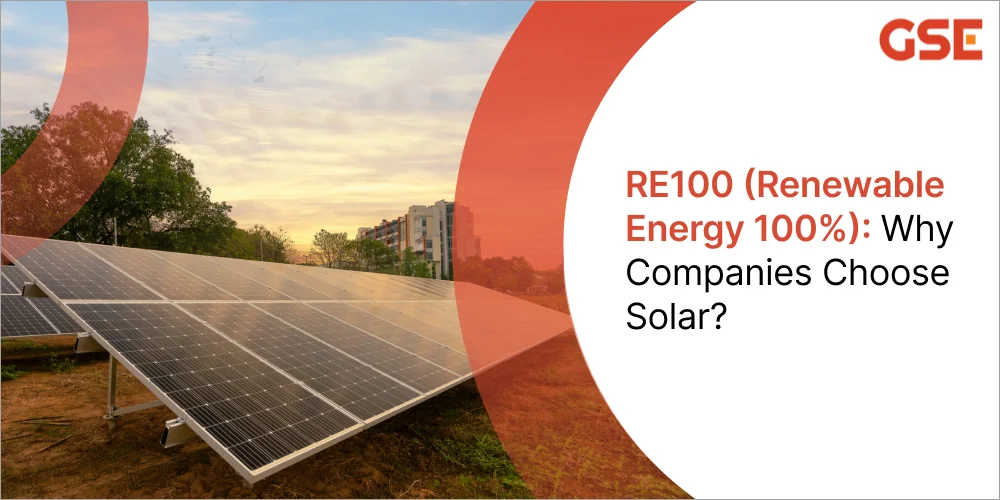500 kW Solar Power Plant Cost in Gujarat: Complete Price & Savings Guide
Nov 26

The worldwide move to sustainable energy it is not just a trend its now adopting speed and RE100 (Renewable Energy 100%) ) is right at the heart of this corporate climate action. RE100 brings together influential businesses, all committed to getting 100% of their electricity from renewable sources. For engineers, sustainability leaders, and particularly energy-intensive industries figuring out how to meet these ambitious targets, one power source keeps coming out on top: solar energy. It’s proving to be the most accessible, quickly scalable, and increasingly smart financial choice for hitting those RE100 renewable energy goals. This isn’t just a popular opinion; it’s backed by solar’s solid technical strengths and its economic sense in today’s decarbonizing world. We’ll break down the engineering, economic, and compliance reasons solar is becoming the go-to for RE100 renewable energy, looking at what it means for everyone from commercial real estate developers to ESG investors, and how we at GSE Renewables help make this vital energy shift happen.
The Origins and Strategic Imperative of RE100
Back in 2014, The Climate Group and CDP launched RE100, a global corporate initiative to speed up the switch to 100% renewable electricity. The idea was simple: businesses use a lot of power, so their collective clout could really push for a cleaner grid. For companies involved, RE100 isn’t just about being green; it’s a smart strategic move that impacts how resilient their operations are and how they’re seen in the market.
The initiative’s goals are designed to make a real difference across the board:
Who’s Involved? A Coalition of Technically Advanced and Influential Entities
More than 400 big multinational companies are part of RE100 now, covering all sorts of industries with heavy energy needs:
Here in India, RE100 is really taking off, especially with engineering-focused and large companies. Infosys, Dalmia Cement (Bharat) Limited, Tata Motors, and Mahindra & Mahindra are already deep into their renewable strategies, offering great examples for other Indian businesses.
These days, corporate sustainability isn’t just a side project; it needs real numbers to back it up and must be part of the main business plan. Switching to renewable energy, especially through RE100, is a huge piece of this, offering clear wins for sustainability leaders and ESG investors.
ESG Metrics Climate Commitments and Financial Disclosures:
Going renewable directly boosts a company’s Environmental Social Governance (ESG) standing:
RE100 doesn’t pick favorites on renewable types, but some are more popular for good technical and economic reasons:
Meeting Stakeholder Expectations: From Investors to Regulators:
The push to decarbonize is coming from all directions now:
An RE100 commitment is a solid sign that a company is serious about managing its environmental impact and is strategically ready for a low-carbon future. That’s crucial for keeping investors happy and staying a market leader.
Solar energy’s rise as the top pick for RE100 strategies isn’t by chance. It’s a smart combination of mature technology, economic benefits, and flexible deployment that really clicks for engineers, sustainability leaders, and energy-hungry industries.
When looking at RE100 options, a straight technical and economic comparison shows why solar often comes out ahead for most companies.
This all-around technical and economic strength makes solar a very practical and smart financial pick for a wide range of RE100 companies.
Choosing solar doesn’t just feel good; it gives companies solid ways to meet RE100’s tough compliance rules, which is a big deal for sustainability leaders and ESG reporting.
Engineers and project managers know that while solar is great, there are technical and logistical hurdles to clear for a successful RE100 solar strategy:
At GSE Renewables, we offer specialized engineering, procurement, construction (EPC), and consulting to help RE100-focused companies turn their renewable dreams into working realities. We guide engineers, sustainability leaders, and large businesses through the technical, financial, and regulatory maze of going solar.
Our End-to-End Services for RE100 Solar Implementation:
RE100 Renewable Energy is a landmark commitment for any company. For engineers, sustainability leaders, and businesses looking ahead, solar energy presents the most solid, technically sound, and financially smart way to hit that 100% renewable electricity goal. Its scalability, falling costs, and direct cut to Scope 2 emissions make it a powerful answer for meeting stakeholder demands and building a resilient business for the long haul. The strategic need to adopt solar is undeniable.
Partner with GSE Renewables. We engineer your solar roadmap, making sure your RE100 journey is technically strong, financially smart, and successfully delivered.
Our Blogs With a combined experience of over 250 years and the successful management of 30 MW of solar energy projects, GSER offers the most efficient solutions. 500 kW Solar Power Plant Cost in Gujarat: Complete Price & Savings Guide What is a 500 kW...
Read MoreOur Blogs With a combined experience of over 250 years and the successful management of 30 MW of solar energy projects, GSER offers the most efficient solutions. Why Solar Power Is Booming in Gujarat for Businesses Over the last decade, Gujarat has become one of...
Read MoreOur Blogs With a combined experience of over 250 years and the successful management of 30 MW of solar energy projects, GSER offers the most efficient solutions. Solar Opex Model: For Rooftop Solar with No Upfront Investment What is the OPEX Model in Solar Energy?...
Read More